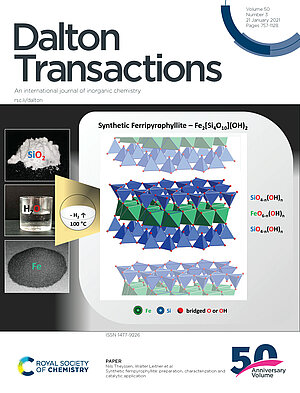First artificial synthesis of ferripyrophyllite under exceptionally mild conditions.
It was a chance discovery and is an example of the successful cross-institutional collaboration between the MPI für Kohlenforschug and the MPI CEC.
When performing catalytic reactions in water as a solvent, Dr. Yunxiang Qiao, a postdoctoral researcher in Prof. Leitner's department at MPI CEC, worked with two different reactors. Both autoclaves were made of steels with a nickel-based alloy (Hastelloy). While one autoclave used a stirrer shaft made of normal V4A stainless steel, the second variant used a magnetic, Teflon-coated stirrer core.
Images taken with a transmission electron microscope (TEM) showed that only in the reactor with the stainless-steel stirrer shaft a phase transformation of the SBA-15 (a mesoporous form of silicon dioxide (SiO2)) occurred and an iron silicate was formed. The substance did not appear in any analytical database to that date.
The discovery of this phase transformation by Bernd Spliethoff in electron microscopy at the MPI für Kohlenforschung, was intensively analyzed and studied by both Mülheim MPIs in the past years.. Dr. Qiao developed a specific protocol for the synthesis of the iron silicate. The first synthesis protocol for pure iron-based pyrophyllite.
In order to understand the structure of the iron silicate in detail, different research groups cooperated intensively. Many years of research have shown that only an iron source (e.g. iron powder), a mesoporous SiO2 source (SBA-15, MCM-41, or simple silica) and water are needed to synthesize the iron silicate. In addition, it turned out that this reaction proceeds under very mild conditions - at 100 °C and only under the vapor pressure of water - and purities of about 95% can be easily achieved after workup. Moreover, despite its filigree morphology, the iron silicate is very temperature stable. The synthesis of other known iron silicates requires pressures of mostly 1000 bar and significantly higher temperatures.
Dr. Eckhard Bill, head of the Joint-Workspace at MPI CEC, made very valuable contributions to the analysis of the structure by using Mößbauer spectroscopy. In addition, several scientists from the department of Prof. Ferdi Schüth (Director MPI für Kohlenforschung), also with the participation of the groups of Dr. Claudia Weidenthaler, Dr. Wolfgang Schmidt, and Dr. Gonzalo Prieto, investigated the iron silicate. Last but not least, catalytic testing of the material in ammonia synthesis by Jan Folke, postdoc in the group of Dr. Holger Ruland (department of Prof. Robert Schlögl), provided further significant insights. Prof. Walter Leitner, Head of the Department of Molecular Catalysis at the MPI CEC, provided scientific support for the investigations and, together with Dr. Nils Theyssen, Head of the Technical Center at the MPI für Kohlenforschung, interpreted the results of the analyses in conclusion.
The material is a promising catalyst support material and is also interesting as a catalyst for iron-catalyzed reactions. Researchers from the two institutes have already been able to incorporate selected other metals (both main group and transition metals) into the structure. This is an important step in catalysis research and is particularly promising for the use of solid catalysts.
The research work was recently published in the journal Dalton Transactions and highlighted as a topic for the Inside Front Cover.
Original publication: Yunxiang Qiao, Nils Theyssen, Bernd Spliethoff, Jan Folke, Claudia Weidenthaler, Wolfgang Schmidt, Gonzalo Prieto, Cristina Ochoa-Hernández, Eckhard Bill, Shengfa Ye, Holger Ruland, Ferdi Schüth, Walter Leitner (2021) Synthetic ferripyrophyllite: preparation, characterization and catalytic application. Dalton Trans., 2021,50, 850-857.
https://doi.org/10.1039/D0DT03125A

